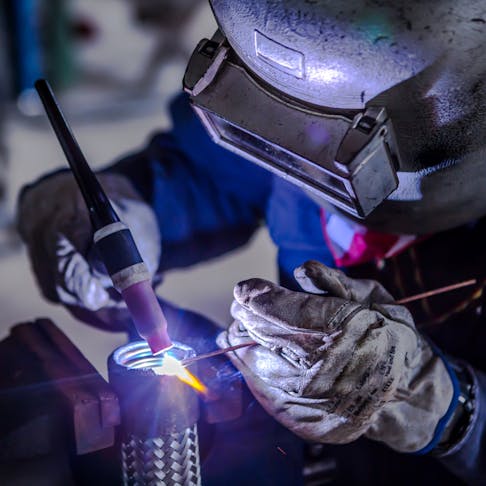The Importance of Welding WPS: Making Sure High Quality and Security in Your Jobs
The Ultimate Guide to Welding WPS Procedures: An Extensive Introduction for Welders
In the complex globe of welding, Welding Procedure Requirements (WPS) function as the backbone of ensuring quality, uniformity, and safety and security in welding operations. Recognizing the subtleties of developing, carrying out, and monitoring WPS treatments is crucial for welders aiming to elevate their craft and meet market standards. As we delve into the numerous components of a WPS and discover the complexities of certification and qualification, we will uncover the essential duty these procedures play in the world of welding. Allow's start a trip to untangle the complexities and value of WPS procedures in welding techniques.
Significance of WPS Procedures
Recognizing the relevance of Welding Treatment Specs (WPS) procedures is vital for making certain the quality and integrity of bonded frameworks. WPS treatments work as a roadmap for welders, outlining the essential actions, parameters, and products needed to accomplish an audio weld. By adhering to WPS standards, welders can guarantee uniformity in their work, leading to reliable and structurally sound welds.
Among the main reasons that WPS treatments are important is their duty in preserving weld high quality and stability. Following the specified welding parameters and techniques outlined in the WPS aids prevent issues such as porosity, splitting, or insufficient blend, which can compromise the strength and sturdiness of the weld. In addition, WPS treatments are important for making certain conformity with sector requirements and codes. By complying with well established WPS guidelines, welders can show that their work meets the required demands for safety and high quality, providing guarantee to clients, inspectors, and regulatory bodies. Essentially, the importance of WPS treatments can not be overemphasized, as they are fundamental to achieving constant, high-grade welds that satisfy industry criteria and specs.

Parts of a WPS
A Welding Procedure Specification (WPS) normally makes up important components that detail the details needs for executing a weld, making certain uniformity and high quality in the welding process. The vital elements of a WPS include essential variables such as base steels, filler steels, interpass and preheat temperature levels, welding procedures, protecting gases, welding settings, and post-weld warmth treatment needs.
Base steels refer to the materials being signed up with, while filler metals are made use of to fill up the space between the base metals during welding. The welding procedure lays out the particular method to be made use of, whether it's gas steel arc welding (GMAW), secured metal arc welding (SMAW), or another method. Welding positions define the orientations in which welding can be performed.

Credentials and Qualification
Having established the important elements of a Welding Treatment Requirements (WPS), the emphasis currently moves towards the important aspects of certification and qualification in welding techniques.

Accreditation, on the various other hand, is the official acknowledgment of a welder's qualifications by an appropriate accreditation body or organization. Welding qualifications are normally based on the details welding processes, products, and settings a welder is certified to deal with. Holding a valid welding accreditation demonstrates advice that a welder meets market requirements and is competent to do welding tasks to the required specifications.
Developing a WPS
To develop a Welding Treatment Specification (WPS) that meets sector requirements, mindful consideration of welding processes, products, and functional specifications webpage is important (welding WPS). The very first step in creating a WPS is to recognize the welding process to be utilized, such as gas metal arc welding (GMAW) or secured steel arc welding (SMAW) As soon as the welding process is figured out, the following important facet is choosing the proper products, taking into consideration elements like base steel type, density, and joint layout. Operational parameters such as welding present, voltage, travel speed, and protecting gas structure have to likewise be thoroughly defined in the WPS.

Carrying Out and Monitoring WPS
Upon wrapping up the comprehensive Welding Procedure Requirements (WPS) that thoroughly information welding processes, materials, functional specifications, and high quality assurance steps, the focus moves to effectively carrying out and monitoring the recognized treatments. Application involves guaranteeing that all welders included in the task are acquainted with the WPS and follow it meticulously throughout the welding procedure. Efficient execution and surveillance of the WPS are critical for guaranteeing the honesty, stamina, and safety of the welded joints, ultimately contributing to the general success of the welding task.
Verdict
Finally, understanding and complying with Welding Procedure Requirements (WPS) is critical for welders to guarantee quality, consistency, and security in their job. By knowing the elements of a WPS, getting appropriate certifications and accreditations, creating comprehensive procedures, and carrying out and checking them efficiently, welders can enhance their abilities and efficiency in welding practices. Complying with WPS procedures is crucial for producing high-quality welds and conference sector criteria.
In the elaborate globe of welding, Welding Procedure Requirements (WPS) offer as the backbone of making certain quality, consistency, and safety in welding operations. The welding process lays out the details method to be used, whether it's gas steel arc welding (GMAW), protected metal arc welding (SMAW), or another approach.To create a Welding Treatment Spec (WPS) that fulfills market criteria, careful consideration of welding processes, materials, and functional criteria is vital. The initial step in developing a WPS is to identify the Go Here welding procedure to be utilized, such as gas steel arc welding (GMAW) or secured metal arc welding (SMAW)Upon settling the detailed Welding Treatment Spec (WPS) that carefully details welding processes, materials, functional specifications, and top quality assurance procedures, the focus shifts to properly applying and keeping an eye on the recognized procedures.